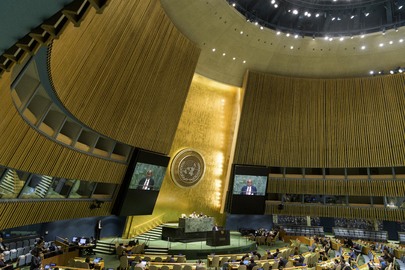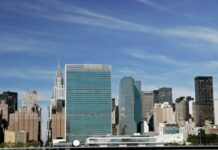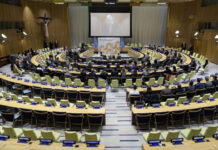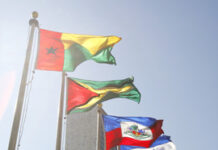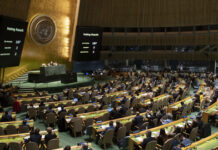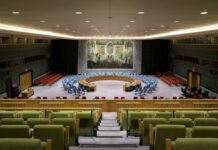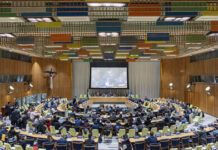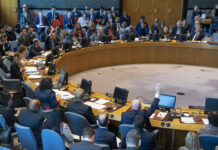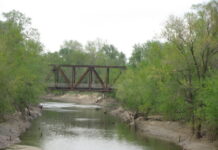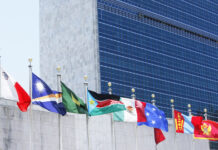Amy Fraenkel: The conventional migratory species has its roots in the watershed meeting in Stockholm in 1972, which was the first ever UN meeting on the environment, and the reason for this treaty is very, very straightforward, which is that the kind of animals that we’re dealing with are those that migrate and cross national borders. And that means already that for their survival, for their well-being, for their conservation we have to bring countries together. Because if one country doesn’t protect a species that is endangered, let’s say, and another one does, then you know we don’t have an even playing field across the range of the species.
The basic premise of the treaty is to identify species that need to have some help in terms of their conservation status, that need to bring governments together to work on very specific and you practical conservation solutions as well as looking at cross cutting issues such as the kinds of threats that we have to deal with.
UN News: Could you give a couple of examples of those species which demand special attention and also the threats for those species?
Amy Fraenkel: We deal with species in every type of environment, meaning birds, avian species, terrestrial species including mostly mammals, as well as aquatic species.
So maybe starting with aquatic species, we have numerous whale species, for example and all of the sea turtles, the great sea turtles. The reason they need to be on the treaty is because they encounter in their migration many kinds of risks, including bycatch in fisheries, when we’re talking in the oceans. As well as for turtles in their nesting areas where they come to lay their eggs, there can be destruction of those nests. Light pollution can cause stress and changes in the behaviour and even gender of the turtles in some cases. So that’s one example.
Moving to the land, we have species such as the jaguar, which is found in Latin America. Very important species that covers a very wide range. It crosses so many different countries, that its survival is dependent on having countries come together to agree on measures to protect it and make sure it continues to exist. These animals need to be able to move, but if they meet a road or a fence or a railroad, etcetera, they’re not going to be able to travel. So, looking at ways to ensure that there’s good connectivity of corridors for those species to move between areas and including across borders is also very critical.
And then moving to through our skies, we have the most species listed on CMS, in fact, our bird species, and there are many different species. Everyone has a favourite. The osprey is one that I love because it’s found everywhere in the world and the osprey. It’s a good news story in many places. Because one of the early threats to some species were some of the chemicals that were used, some of the insecticides. And the ospreys were among the species impacted, and they’ve recovered from that.
The fact is that for each of the species that we deal with, there really are a set of circumstances where it’s found and what countries have to be involved and what are the particular conservation needs and threats.
UN News: Is there any particular results the Convention can be proud of?
Amy Fraenkel: They picked out in the report 14 species in particular, where there’s been a lot of progress that includes the humpback whale. And it was a combination of reduced reduction of commercial whaling, but also addressing other issues like bycatch in fisheries as well as ship strikes, which is another set of issues.
Another good example is the vicuna, which is a beautiful animal found in the Andes. And that animal also had been in a very steep decline and it’s doing tremendously better. So, it’s just two quick examples. But the point is we know what needs to be done. There is definitely a lot of reason for hope. And what we need is to first and foremost ensure that CMS is fully and effectively implemented.
In some cases, we can have a regional approach. For example, we have an initiative in Central Asia, it’s called the Central Asian Mammal Initiative. And all of the five Central Asian countries and a few others, including Mongolia, are at the table and there we look at all species of antelope and gazelle.
The countries have agreed on a set of priorities and there are some good successes, including the saiga antelope, which have been in massive decline. And there’s now maybe 2 million of them in Kazakhstan. So, it’s really wonderful to see that kind of a result.
UN News: What are the expectations from CMS Convention of Parties? What do parties to the Convention intend to discuss and maybe set forward some plans for the future?
Amy Fraenkel: We have a very robust agenda for next week with dozens of different topics on policies for the different types of species. There are cross cutting issues. And one such issue is light pollution. I believe, 2 per cent per year is the growth now that we’re seeing of the amount of Earth that is lit at nighttime. In nature, there’s not a lot of fake light. It’s not the natural habitat. And so light, like other kinds of disturbances, can actually have a pretty severe impact on numerous migratory species.
And one example is birds. When birds are migrating, if they are distracted by light pollution, they can be drawn into cities, you know, lose their correct course. And then have fatalities. It’s actually killing hundreds of millions of births a year. It is something that’s very solvable, and we have experts that have come together with guidelines that can be applied globally to that issue. We’re hoping to adopt and launch those just as one example.
Climate change is on the agenda. Wildlife disease is on the agenda and other area that we do a lot of work on. It’s an extremely active COP and a very active convention. And it’s going to be an incredible COP. We have an amazing host here in Samarkand, Uzbekistan. We expect a record number of attendees, and we are very hopeful for some excellent results at the end of the week.
UN News: A lot can be done on the level of political decisions. Is there anything that people in their everyday life could do to facilitate the improvement of conditions for migratory species?
Amy Fraenkel: Absolutely. First coming back to the point on light pollution. The guidelines are broad, and while some of them are aimed at governments and cities, for example, cities can do a lot or private sector, so can any person who has a home and can learn how to reduce the impact of light pollution. That can include, of course, shutting off the light at night, but also even the type of light that they use, or the way that they shine it. That already would be a very helpful measure.
Another aspect, which is controversial in some discussions, but when people have domestic animals, some of those animals can have a pretty significant impact on wild species. That includes domestic cats. There’s a lot of science studies on that, and the vast numbers of birds that can be killed because of cats doing what they do. They are predators and it’s not their natural environment. In a way they’re sort of an invasive species in terms of the impacts on the wild species.
Of course, there are broader issues in terms of sustainable use and what people are doing around reducing the use of energy and water. All of those things will contribute to the well-being of ecosystems addressing the broader issues of climate and the species on the planet.
Source of original article: United Nations (news.un.org). Photo credit: UN. The content of this article does not necessarily reflect the views or opinion of Global Diaspora News (www.globaldiasporanews.com).
To submit your press release: (https://www.globaldiasporanews.com/pr).
To advertise on Global Diaspora News: (www.globaldiasporanews.com/ads).
Sign up to Global Diaspora News newsletter (https://www.globaldiasporanews.com/newsletter/) to start receiving updates and opportunities directly in your email inbox for free.


